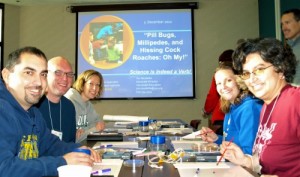Professional Development Materials
Professional Development Materials: Biodiversity PD Materials Carbon PD Materials Citizenship PD Materials Water PD Materials
Professional Development Materials
The Pathways to Environmental Science Literacy Project, a National Science Foundation Math Science Partnership, aimed to increase students’ understanding of key environmental concepts and in turn their abilities to make decisions about environmental issues using scientific evidence. Pathways Project members (including scientists, education researchers, and secondary educators from four Long Term Ecological Research sites –www.lternet.edu) saw a need to provide intensive summer and school year professional development (PD) for teachers working to increase student understanding of environmental concepts. A cross-site professional development program was developed to train teachers in environmental science research and teaching techniques and to learn about the Pathways Project’s education research into student thinking and learning. Information from the project’s PD programs is included in the documents below which describe best practices for using learning progression-based teaching practices in professional development programs.
There are three questions PD Leaders/Providers need to consider in order to implement effective PD.
- What are the goals for student development of principle-based reasoning and the theory of action or model you will use to help students learn? What do you want students to learn, be able to do, and/or feel? What is your theory of action or model for students learning of these things?
- Construct a conceptual understanding of science content (While keeping your goals in mind, it may be useful to utilize a graphical organizer or table to connect big ideas or concepts (columns) and cross-cutting ideas or skills (rows).
- Student movement through a learning progression model towards principle-based reasoning
- What are our goals for teachers and how they will learn?
- Connect their prior understandings of inquiry-based learning and teaching of science by immersion as a student in to a Learning Progreesion based model and learn how to apply it as a teacher.
- Assess and analyze (recognize) where students are on a Learning Progression by using learning progression-based teaching practices and apply learning progression-based teaching practices appropriately to move students on a LP model.
- What are the goals for PD Providers and how they develop their PD programs for teachers?
- Model LPTP in PD with science teachers
- Deepen science teacher content and pedagogical knowledge
- Understand the supports and constraints associated with implementing PD
We have developed supporting materials for professional development providers to use when developing PD modules:
- Zip file with materials for comparing learning goals for the Carbon, Water, and Biodiversity strands with the NRC Framework for K-12 Science Education (Download)
- Example Agendas for Professional Development (One-day example), (Multiday example)
- Example Evaluations
We have developed professional development materials for each of research strands:
* This research is supported in part by grants from the National Science Foundation:Targeted Partnership: Culturally relevant ecology, learning progressions and environmental literacy (NSF-0832173). Any opinions, findings, and conclusions or recommendations expressed in this material are those of the author(s) and do not necessarily reflect the views of the National Science Foundation.
